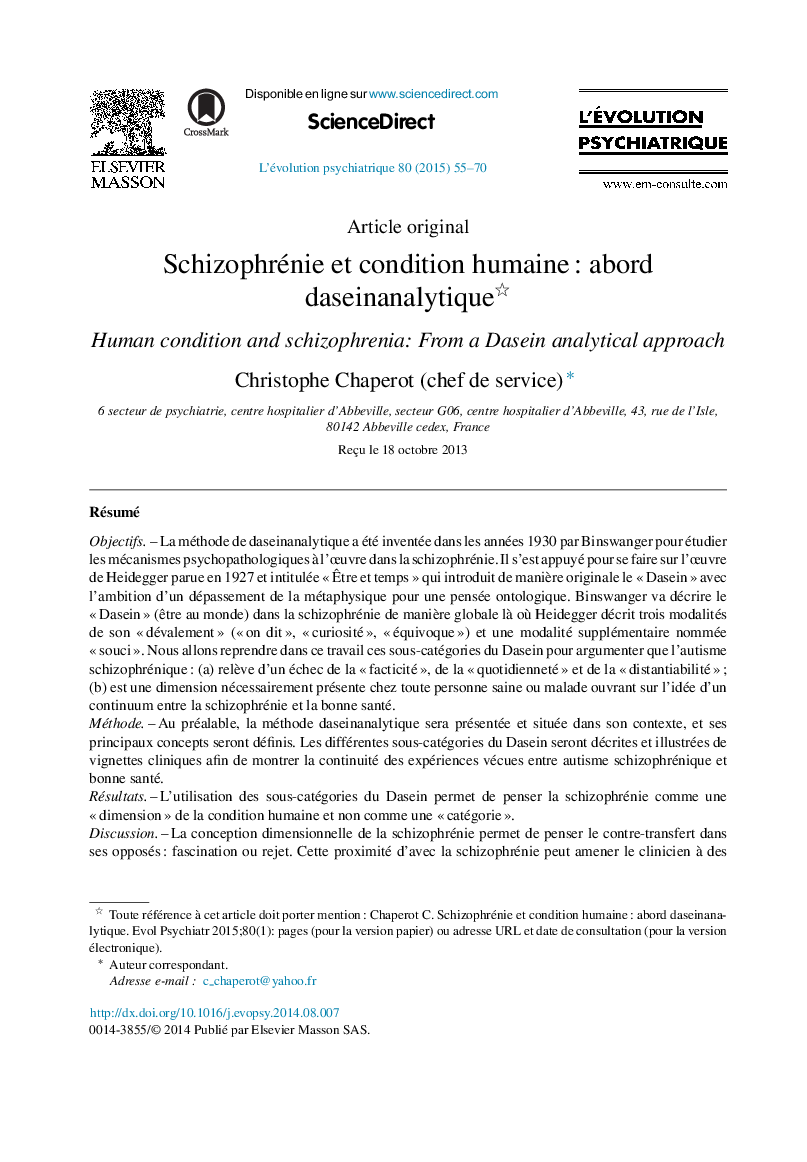| Article ID | Journal | Published Year | Pages | File Type |
|---|---|---|---|---|
| 908621 | L'Évolution Psychiatrique | 2015 | 16 Pages |
RésuméObjectifsLa méthode de daseinanalytique a été inventée dans les années 1930 par Binswanger pour étudier les mécanismes psychopathologiques à l’œuvre dans la schizophrénie. Il s’est appuyé pour se faire sur l’œuvre de Heidegger parue en 1927 et intitulée « Être et temps » qui introduit de manière originale le « Dasein » avec l’ambition d’un dépassement de la métaphysique pour une pensée ontologique. Binswanger va décrire le « Dasein » (être au monde) dans la schizophrénie de manière globale là où Heidegger décrit trois modalités de son « dévalement » (« on dit », « curiosité », « équivoque ») et une modalité supplémentaire nommée « souci ». Nous allons reprendre dans ce travail ces sous-catégories du Dasein pour argumenter que l’autisme schizophrénique : (a) relève d’un échec de la « facticité », de la « quotidienneté » et de la « distantiabilité » ; (b) est une dimension nécessairement présente chez toute personne saine ou malade ouvrant sur l’idée d’un continuum entre la schizophrénie et la bonne santé.MéthodeAu préalable, la méthode daseinanalytique sera présentée et située dans son contexte, et ses principaux concepts seront définis. Les différentes sous-catégories du Dasein seront décrites et illustrées de vignettes cliniques afin de montrer la continuité des expériences vécues entre autisme schizophrénique et bonne santé.RésultatsL’utilisation des sous-catégories du Dasein permet de penser la schizophrénie comme une « dimension » de la condition humaine et non comme une « catégorie ».DiscussionLa conception dimensionnelle de la schizophrénie permet de penser le contre-transfert dans ses opposés : fascination ou rejet. Cette proximité d’avec la schizophrénie peut amener le clinicien à des contre-attitudes iatrogènes. Penser cette proximité peut, a contrario, aider le clinicien à adopter une posture, une subjectivation thérapeutique.ConclusionUne reprise daseinanalytique des sous-catégories du Dasein schizophrénique permet de concevoir une continuité entre autisme schizophrénique et bonne santé, ce qui aboutit à l’idée de la schizophrénie comme « dimension » et non plus comme « catégorie ». Les conséquences en termes de conception thérapeutique sont importantes puisque, d’une part, le « contre-transfert » se pense de manière différente, et, d’autre part, le « soin » va correspondre à l’aide au développement d’une « facticité » assumée. Par ailleurs, aborder le problème de la schizophrénie de cette manière oblige à penser la possibilité de « schizophrénies psychotiques » et de « schizophrénies non psychotiques ».
ObjectiveThe Dasein analytical method was invented in the thirties by Binswanger to study the psychopathological mechanisms implied in schizophrenia. To do so, Binswanger relied on the work of Heidegger published in 1927 and entitled “Being and Time” that introduced in an original manner the “Dasein” with the idea of transcending metaphysics for an ontological reflection. Binswanger describes the schizophrenic “Dasein” (translated in English as ‘existence’, ‘being in the world’) in its globality, whereas Heidegger describes three modalities in his “dismantling” (“hearsay”, “curiosity”, “ambiguity”) and a supplementary modality that he names “care”. In this article, we are going to debate on the sub-categories of the Dasein to argument that schizophrenic autism: (a) stems from a failure of “facticity”, of “everydayness” and of “de-distancing”; (b) is a dimension necessarily present in any healthy or sick person implying the notion of a continuum between schizophrenia and good health.MethodAt first, the Dasein analytical method will be presented and situated in its context, and its principle concepts will be defined. The various sub-categories of the Dasein will be described and illustrated by clinical vignettes so as to show the continuity of experiences between autistic schizophrenia and good health.ResultsThe use of sub-categories of the Dasein allows one to consider schizophrenia as a “dimension” of the human condition rather than a “category”.DiscussionThe dimensional conception of schizophrenia permits consideration of the counter-transfer in its opposites: fascination or reject. This proximity with schizophrenia may lead the clinician to iatrogenic counter attitudes. Conversely, thinking of this proximity may help the clinician to adopt an attitude, a therapeutic subjectivation.ConclusionA Dasein analytical approach of the sub-categories of the schizophrenic Dasein permits the conception of continuity between schizophrenic autism and good health, which results in considering schizophrenia as a “dimension” rather than a “category”. The consequences in terms of therapeutic conception are important since on the one hand the “counter-transfer” is though of otherwise and, on the other hand, the “care” will correspond to the help in developing a presumed “facticity”. Moreover, approaching schizophrenia in this way obliges one to consider the possibility of a “psychotic” and “non-psychotic” schizophrenia.
